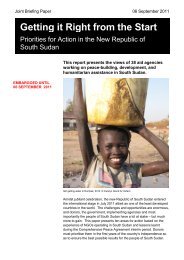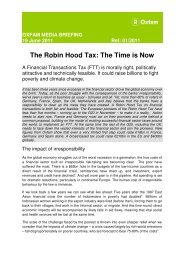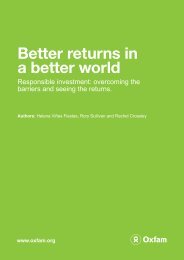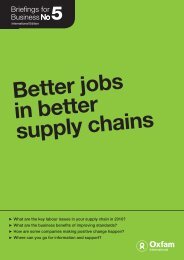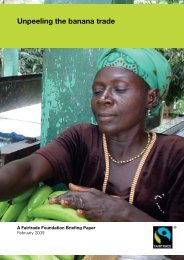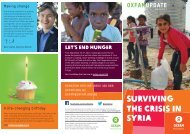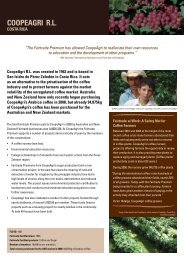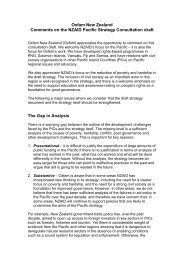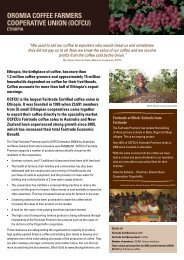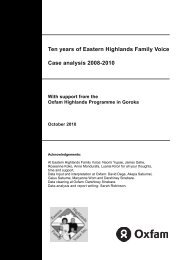Growing a Better Future - Oxfam International
Growing a Better Future - Oxfam International
Growing a Better Future - Oxfam International
- No tags were found...
You also want an ePaper? Increase the reach of your titles
YUMPU automatically turns print PDFs into web optimized ePapers that Google loves.
Box 5: Profits from volatility and volatility from profitsPrice volatility causes havoc for women and men living inpoverty, but presents big opportunities for agribusinessfirms, such as Cargill, Bunge, and ADM that according toone estimate control nearly 90 per cent of global graintrading between them. 95 In times of price stability, tradingmargins are razor-thin, but instability allows the largesttraders to exploit their unrivalled knowledge of reservelevels and expected movements in supply anddemand. 96 In the second quarter of 2008 Bunge saw itsprofits quadruple compared with the same period in2007. The surge in crop prices during the second half of2010 helped Cargill to its best results since 2008, whichChairman and CEO Greg Page attributed to a‘resurgence in volatility across agricultural markets’. 97Similarly, when the 2010 Russian wheat harvest failed,Bunge’s profits ballooned and the company attributedthe windfall to ‘crop shortages related to the drought inEastern Europe’. ‘I hate to say we benefit,’ said CEOAlberto Weisser in an interview. 98Some companies’ activities create volatility in the firstplace, such as the diversion of food crops to biofuels.The biofuel lobby consists of an unlikely alliance ofagribusiness, farmers’ unions, energy companies,and input companies. 99 Its successful push formandates for biofuel content in gasoline and dieselintroduced inelastic demand into food markets, whilethe subsidies and tax breaks won by the biofuels lobbyhelp transmit price movements from oil markets. Bothresult in increased volatility.Attention has also recently turned to pension funds andother institutional investors, because many now aim tohave 3–5 per cent of their investments – representingtrillions of dollars – invested in commodities, includingfood commodities. The UN Special Rapporteur on theRight to Food and others argue that this sudden flood ofdemand is destabilizing and has contributed to pricesurges. Concerned that increasing volatility in foodmarkets may pose risks to their portfolios, someinvestors, such as the French state pension fund FRR,the Dutch state pension fund ABP, and the Californiateachers’ fund CalSTRS, have chosen to limitinvestments in commodities.For poor farmers, the food price crisis brought an abruptend to decades of artificially low prices, depressed byrich countries’ agricultural dumping. Sadly, few could turnhigher prices to their advantage because most were netconsumers of food and nearly all lacked the resources toturn the threat into an opportunity. Price volatility andunpredictable weather discourage poor farmers frominvesting or taking risks, particularly since that may quiteliterally entail betting the farm.Left: Suren Barman with the cow he wasforced to sell. ‘The price of essentials isexcessively high. I cannot afford to buyfood regularly. I am gradually selling mybelongings to maintain my family.’(Dinajpur, Bangladesh 2008)<strong>Growing</strong> a <strong>Better</strong> <strong>Future</strong>Chapter 2: The age of crisis:a skewed and failing system37



